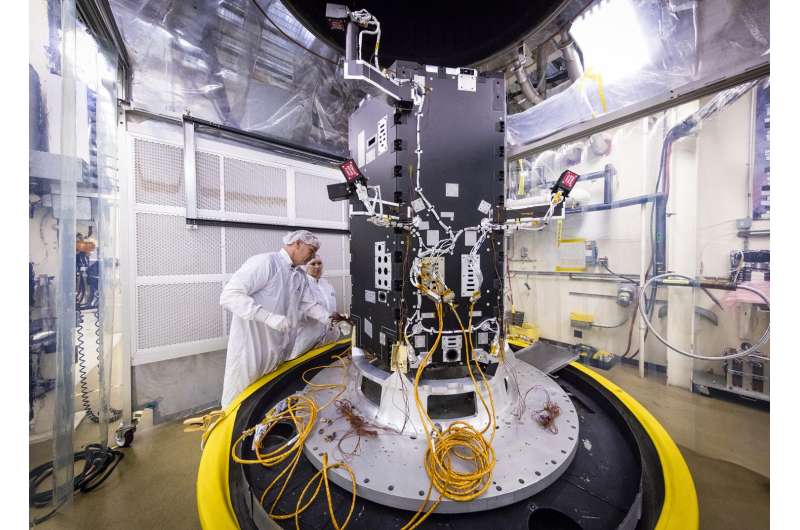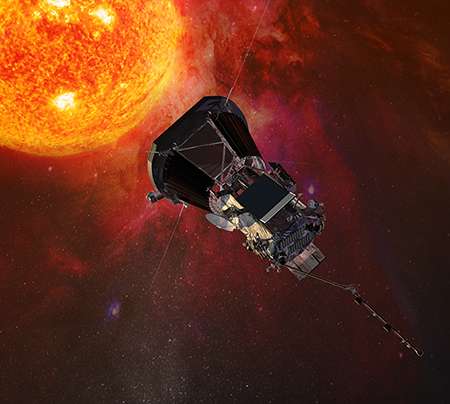Engineers at the Johns Hopkins University Applied Physics Laboratory in Laurel, Maryland, prepare the developing Solar Probe Plus spacecraft for thermal vacuum tests that simulate conditions in space. Today the spacecraft includes the primary structure and its propulsion system; still to be installed over the next several months are critical systems such as power, communications and thermal protection, as well as science instruments. The probe is scheduled for launch in summer 2018. Credit: NASA/JHUAPL.
NASA's first mission to "touch" the sun has passed a critical development milestone that keeps it well on track toward its scheduled summer 2018 launch.
Following a successful NASA management review on July 7, the Solar Probe Plus mission—which will send a spacecraft on several daring data-collecting runs through the sun's atmosphere—is moving into the system assembly, integration, test and launch stage of the project. NASA terms this period as Phase D, during which the mission team will finish building the spacecraft, install its science instruments, test it under simulated launch and space conditions, and launch it.
"Reaching this stage means a lot to the team and our stakeholders," said Andy Driesman, Solar Probe Plus project manager at the Johns Hopkins Applied Physics Laboratory (APL), which manages the mission for NASA and is building the spacecraft. "It shows we've designed a spacecraft, instruments and a mission that can address the engineering challenges associated with the harsh solar environment, and send back the data that scientists have sought for decades. It's humbling to see designs and ideas start to become a spacecraft."
Solar Probe Plus is set to launch during a 20-day window that opens July 31, 2018. Over 24 orbits, the spacecraft will use seven flybys of Venus to reduce its distance from the sun. The closest three orbits will be within 3.9 million miles of the sun's surface—roughly seven times closer than any spacecraft has come to our star—where it will face solar intensity more than 500 times what spacecraft experience while orbiting Earth.
Artist's impression of the Solar Probe Plus spacecraft. Credit: NASA/JHUAPL.
This mission of extreme exploration will provide new data on solar activity and contribute significantly to our ability to forecast major space-weather events that impact life on Earth. The primary science goals for Solar Probe Plus are to trace the flow of energy from and understand the heating of the sun's outer atmosphere—its corona—and to explore the physical mechanisms that accelerate the solar wind, the continuous stream of charged and energetic particles flowing out from the sun. To do that requires sending a probe through the corona to better understand the solar wind and the material it carries into our solar system. It's been a goal of scientists for nearly 60 years, one that is only possible today through cutting-edge thermal engineering advances.
Solar Probe Plus will carry four instrument suites designed to study magnetic fields, plasma and energetic particles, and image the solar wind. The spacecraft and instruments will be protected from the sun's heat by a 4.5-inch-thick carbon-composite shield, which will need to withstand temperatures that reach nearly 2,500 degrees Fahrenheit—but keep the spacecraft's payload operating at room temperature.
Solar Probe Plus is part of NASA's Living With a Star program to explore aspects of the sun-Earth system that directly affect life and society. LWS is managed by the agency's Goddard Space Flight Center in Greenbelt, Maryland, for NASA's Science Mission Directorate in Washington, D.C. APL, in Laurel, Maryland, manages the mission for NASA and is designing and building and will operate the spacecraft.
Provided by Johns Hopkins University
























